The Challenge
Following planned preventative maintenance at Southern Water’s Sandown site, it was discovered that the hoist used to remove their storm pumps did not meet the HSE’s Lifting Operations and Lifting Equipment Regulations 1998 (LOLER). The hoist was therefore taken out of service.
It was imperative that the hoist was quickly put back into action, without incurring high costs.
The Solution
Because of the extent of the damage to the hoist, and the parts and labour costs that a full repair would incur, it was decided that the best course of action would be to replace the entire hoist.
The work also included the addition of a weather cover to slow down the deterioration of the new hoist, ensuring it would remain in service for the duration of its design lifespan.
Thanks to our skilled Street Cranexpress engineers, as well as the comprehensive stocks of hoists kept at our Sheffield site, Sandown Water Treatment Works’ overhead crane was put back into operation with minimal disruption.
Faults identified through the planned service visit
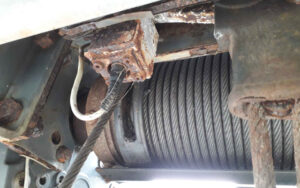
Corroded rope and dead-end assembly on original hoist
- Extreme corrosion of the rope dead end assembly.
- Damaged isolator covers.
- Highly damaged weather covers.
Exposed to the elements
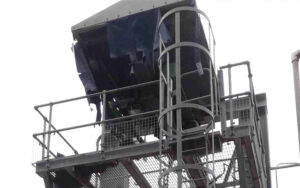
Damaged weather covers
- Upon inspection of the weather cover, the extent of the damage was immediately evident.
- It was clear that the lack of protection from the damaged cover was a contributing factor to the heavy corrosion our engineers had found on the hoist.
- Street Cranexpress replaced the damaged weather cover with an updated, sturdier model.
Replacing the unsafe hoist
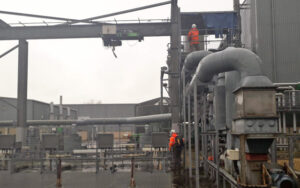
Engineer Mat Targar and apprentice Ryan Targar onsite April 2019
- The existing hoist unit was disconnected from the electrical power supply, before being mechanically disconnected from the runway beam and lowered to floor level..
- A new hoist unit was supplied and installed by our skilled overhead crane engineers.
- A proof load test and a Report of Thorough Examination were produced once the new hoist had been installed.
Ensuring a long lifespan for the new hoist
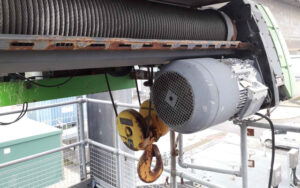
Further corrosion to original hoist steelwork and bottom block assembly
- The project included the addition of a weather cover to the hoist ‘parking area’, for protection of the hoist when not in use.
- The existing power feed festoon trolleys, towing trolley and cables were also replaced to ensure longevity.
Signs of wear
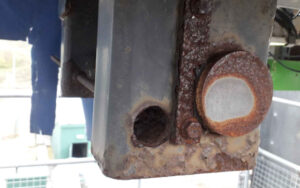
Further irreparable corrosion
- The hoist was in a highly corroded state when our engineers arrived to complete their service.
- Corrosion is a natural process of deterioration, which is sped up by exposure to adverse weather; the process can be slowed by protection from the elements.
- When corrosion is found on any lifting equipment, the integrity of that part comes into question, and no risks can be taken.
Proof load testing
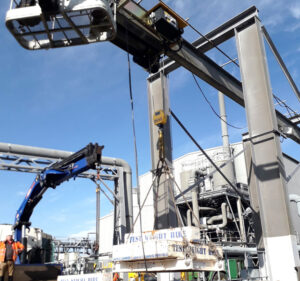
Street Cranexpress carrying out the proof load test of the newly installed Street hoist.
- After installation of the hoist, a proof load test was required.
- As per standard commissioning procedure, a proof load test of 125% of the Safe Working Load was carried out on site.
- The test was performed in a safe, controlled environment under a lifting plan that was devised by the senior engineer assigned to the job.
- The new hoist successfully passed the load test and overload devices were set in the process.
Provided as standard
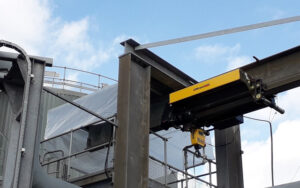
New hoist in situ
- Mobile powered access equipment.
- Mobile crane/ancillary lifting equipment.
- Weights for testing and commission purposes.
- Risk Assessment and Method Statement documentation.
- Lifting plans created by a trained Appointed Person (AP).
